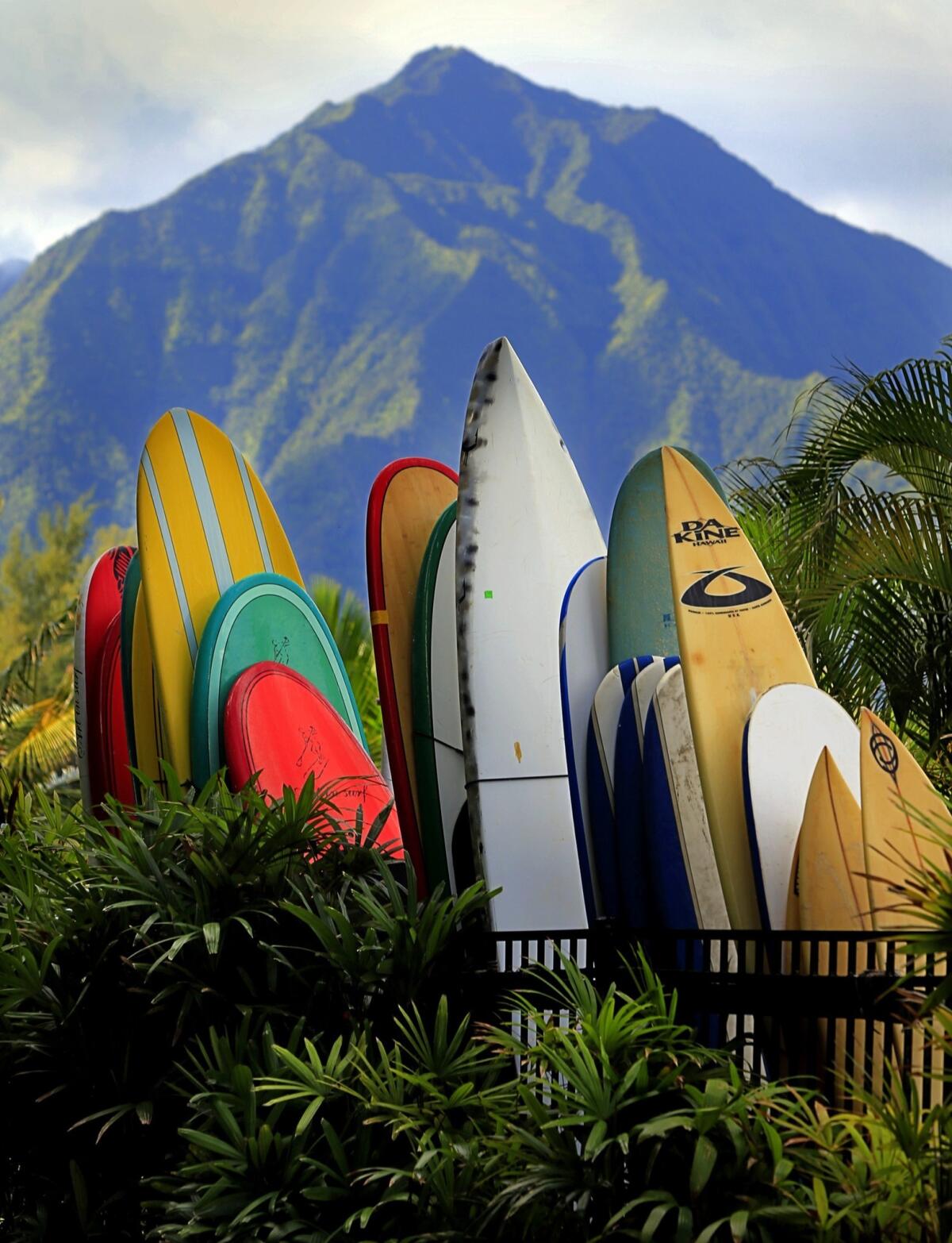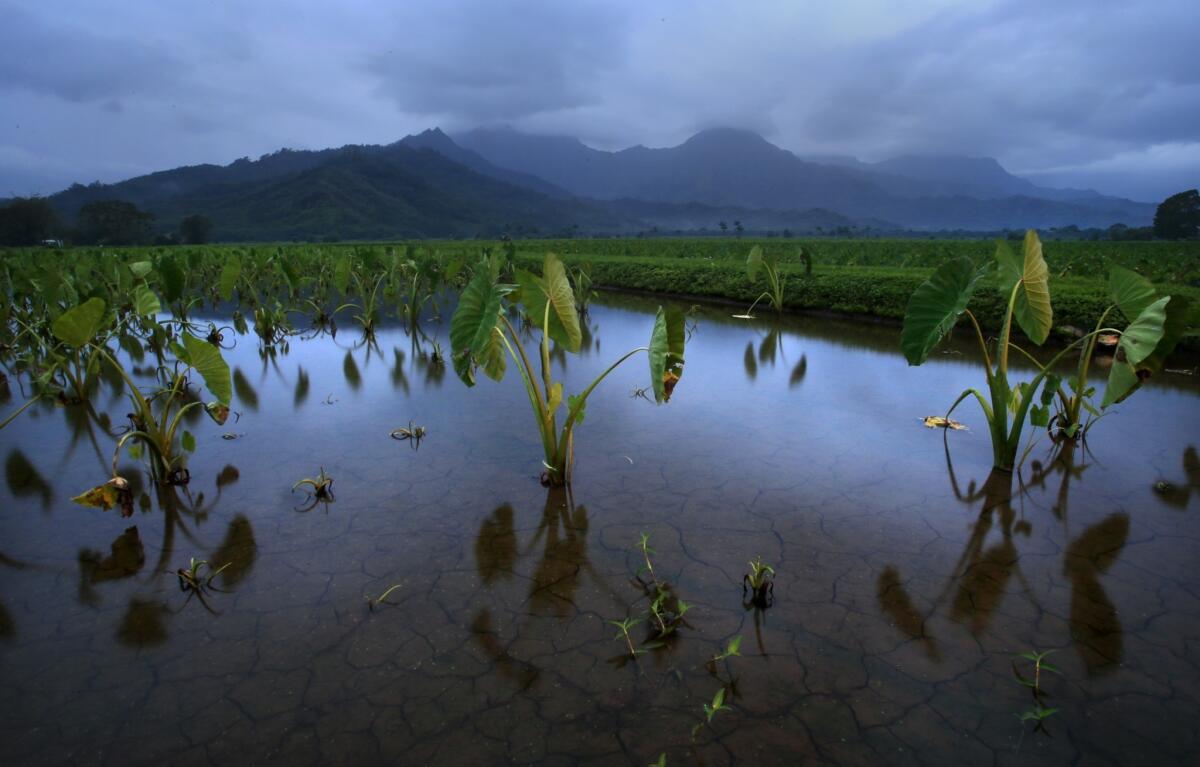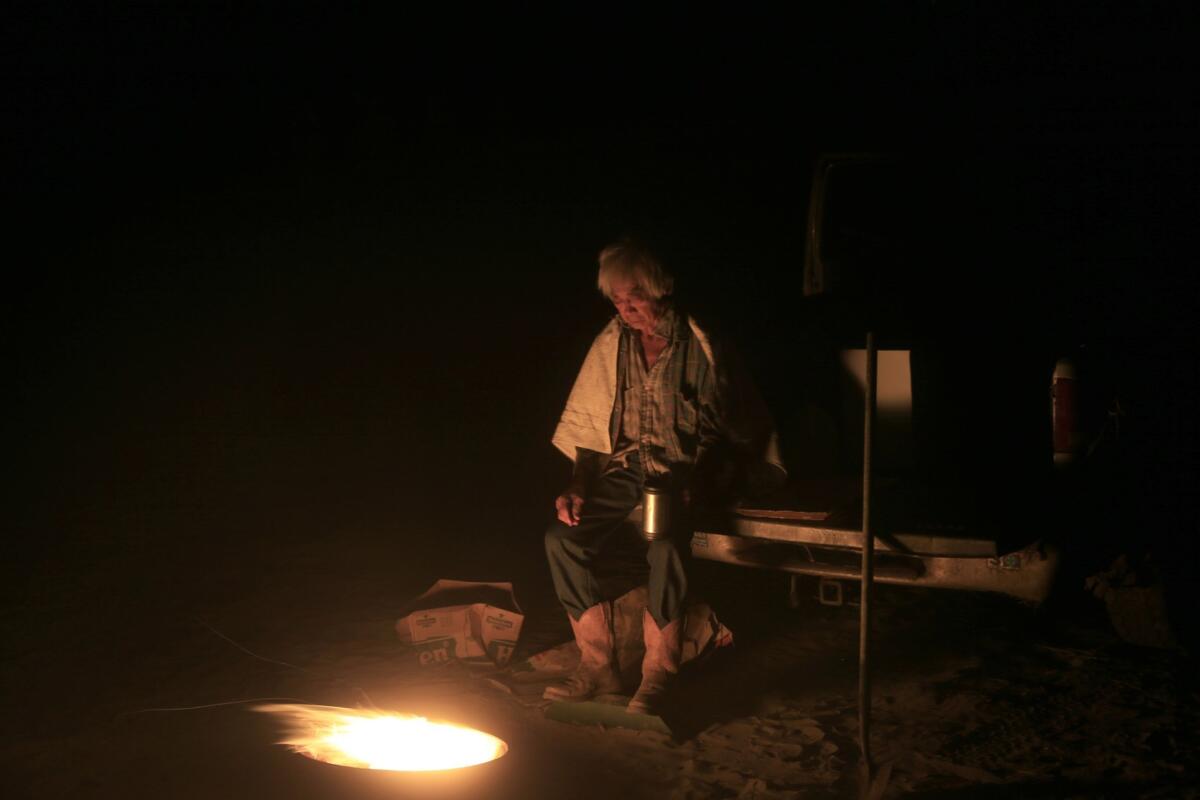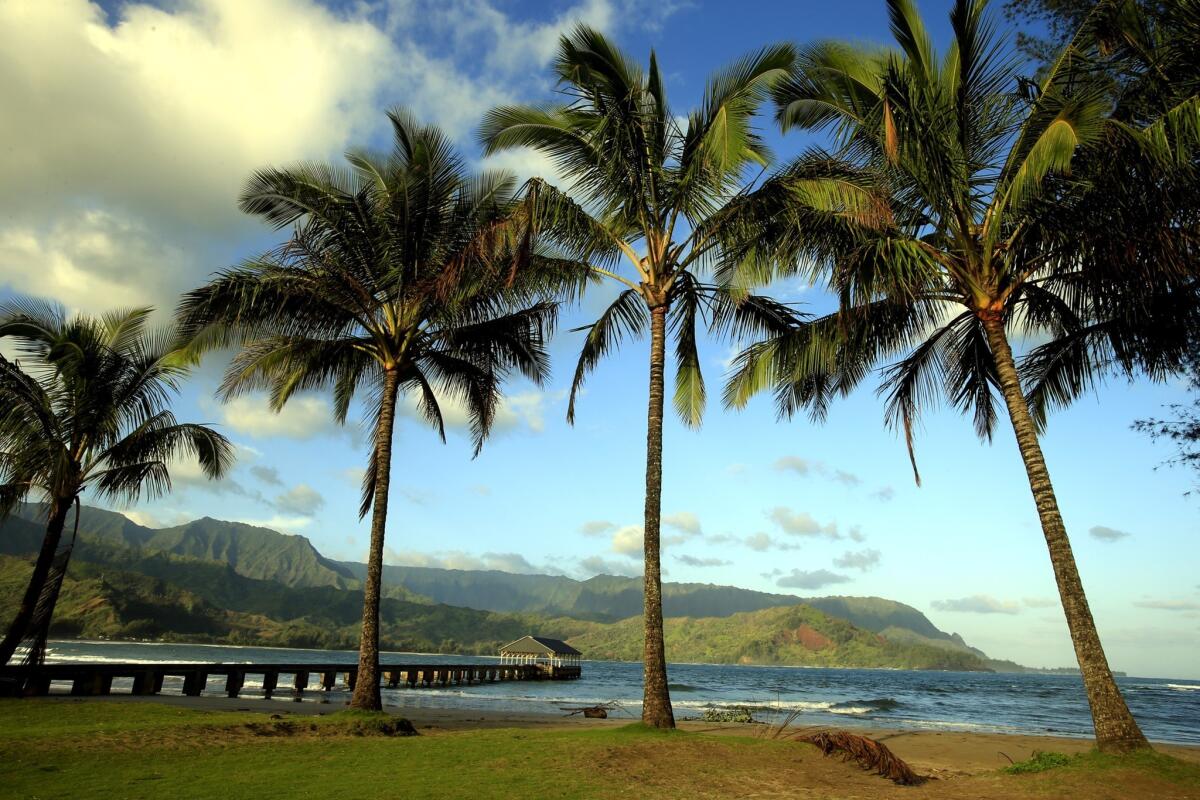On Kauai’s North Shore, Mother Nature paints with green
The north coast of Kauai is a place of spiky green ridges and plunging waterfalls. In low-key Hanalei, nature beckons this visitor despite Princeville resort traffic and a patch of iffy weather.
- Share via
On the North Shore of Hawaii's northernmost island, the earth writhes like a topographer's fever dream — 3,000-foot cliffs, plunging waterfalls, tangled green valleys and sharp, serrated ridgelines. That's the Na Pali Coast.
Just east of those cliffs, Kauai's Kuhio Highway carries you past taro fields, a seaside village, a two-mile crescent of sand and a 300-foot pier that's dwarfed by mountains, greenery and surging surf. This is Hanalei Bay, which Hollywood would have had to create if Mother Nature hadn't.
You might know this neighborhood from "South Pacific" (1958). Or "The Descendants" (2011). Or — attention, TV geeks — the pilot for "Gilligan's Island" (shot in 1963).
If Waikiki is the classic crowded Hawaiian beach, the North Shore is the iconic coastal outpost.
But everything looks a bit different when you get up close. So L.A. Times photographer Mark Boster and I arrived in February, eager to poke around when the crowds are smaller and the surf is bigger.
Our timing on this trip was not good. We rolled in amid sluggish traffic, thanks in part to Kuhio Highway's many beloved one-lane bridges and in part to high occupancy in the Hanalei-adjacent resort area of Princeville. The waves were not just big but massive and sloppy, forcing cancellation of most watersports and boat tours. Strong winds, sometimes gusting close to 40 mph, grounded helicopter tours. Clouds filled the sky for days. Our first purchase, two bags of groceries in Kapaa, came with a bonus population of bugs.
Greater Hanalei (population about 450) didn't feel quite like paradise. But even then, it was easy to look at.
For me, the center of gravity was the Hanalei Pier, so I spent a lot of time there as fishermen angled for bonefish, local kids leaped into the surf near the "NO JUMPING" sign and feral roosters (endemic on the island) pecked at stray coconuts.
One day on the pier, I met Abe Rivera, 15, who strolled up cradling a feral piglet that he'd caught in the mountains on a bow-hunting expedition with his dad. Another day, Erika Green of Waldorf, Md., turned up in her wedding gown, trailed by her new husband, Tim Green, and wedding planner Diana Gardner of Alohana Weddings.
"Most beautiful place on the island," Gardner said as the Greens trod the pier like models on a runway. "And no one else on the beach!"
Well, almost no one. Jett Yarberry, a 38-year-old surfing instructor and lifelong North Shore boy, is there most days. "I grew up in that valley," Yarberry told me, pointing west. "My parents came here as hippies in 1968 and evolved into normal people."
This is not an uncommon North Shore story. About 45 years ago, Howard Taylor, the brother of actress Elizabeth Taylor, bought several acres at the end of Kuhio Highway by Haena Beach, eight miles west of Hanalei. He couldn't get permission to build, so he invited a band of hippies to live on his land.
For most of the '70s, Taylor Camp housed dozens of free-thinking refugees from the mainland. They built treehouses, raised kids, celebrated nudity, smoked pot and annoyed many islanders before state officials finally bought the land, chased them away and burned down the treehouses.
Now the site is part of Haena State Park, but many of those families remained on the island. (The tale is told in "Taylor Camp," a 2010 documentary directed by Robert C. Stone and coffee table book of the same name by photographer John Wehrheim.)
These days, North Shore visitors are more likely to stay in the hotels and condos of Princeville, play a lot of tennis and golf there, and alternate watersports with hiking, shopping and restaurant exploring in tiny downtown Hanalei.
On the north side of Kuhio Highway, the main drag, you find Ching Young Village, once the site of a lonely general store, now an '80s mini-mall that includes a grocery store, tattoo parlor, several restaurants and ample kitsch and grit. On the south side stands Hanalei Center, a snazzier collection of restaurants and shops in a set of buildings that 80 years ago held the town elementary school. On the south side of the street, you can pay $7.75 for a macadamia nut shake at Shave Ice Paradise or browse antique Polynesian weapons at Yellowfish Trading Co.

Surfboards and paddle boards for guests are stacked together at the St. Regis Princeville resort. More photos
On both sides of the highway and at the beach, you'll see stickers, posters and other reminders of two homegrown heroes. One is Andy Irons, who won three world surfing championships in the 2000s but died in 2010 at 32 when his heart failed after "mixed drug ingestion."
The other is surfer Bethany Hamilton, who was 13 in 2003 when a tiger shark at Tunnels Beach tore off her left arm. Hamilton recovered, returned to surfing and inspired the movie "Soul Surfer" (2011). On March 21, Hamilton won the Surf N Sea Pipeline Women's Pro at Oahu's Banzai Pipeline.
Other stickers we saw all over the North Shore say "Defend Hanalei" — part of the debate over a developer's plans to build an 86-unit hotel and 34 homes on the ridge between the Hanalei River and the St. Regis. That ridge held the Hanalei Plantation Hotel in the '60s and a Club Med in the 1970s but has been idle for more than 30 years. One morning we hiked up there, and when I found the stage where staffers and guests must have danced to the old Club Med "Hands Up" song, I felt like Charlton Heston spotting the Statue of Liberty at the end of "Planet of the Apes."
I understand the locals who lament that tourists and the rich have taken over the North Shore. But I don't think those people are fully in charge yet. If they were, the restaurant service would be faster. Parking on the sand would be banned at Black Pot Beach. Those one-lane bridges on the highway would be widened. And that would be a shame.
It's the weather that's really in charge here: the big waves, the heavy rains on the erosion-carved mountains, the hurricanes and tsunamis that arrive now and then to ravage the coast.

Taro plants glisten in the predawn light. More photos
In fact, it was an iffy decision, toward the end of our visit, to ignore the low-hanging, rain-heavy clouds, wrestle a rented kayak into the water at the river's mouth and paddle away from the tidal tug toward the taro fields of the Hanalei Valley.
But the move paid off. I got just far enough that the sound of traffic faded and the foliage thickened along the shore. The clouds hung heavy but did not burst. I heard birds and murmuring water. And I saw Kauai's green mountains, right side up and upside down, reflected on the smooth surfaces of the river.
Bad timing? Who said that?

Kauai history timeline: How the island evolved
Natural forces are ever visible on Kauai's North Coast. Kauai is volcano-born and sometimes storm-lashed. But mostly it's a gentle place of taro farms and the likes of visitor-friendly Hanalei Pier.
5.1 million years ago: Kauai is the first of several volcanic islands to rise from the Pacific, forming the Hawaiian archipelago.
300-500: First Polynesian explorers and settlers reach the islands.
1778: Capt. James Cook lands on Kauai's south shore. He and his crew are the first Europeans to reach Hawaiian soil. Within two years, they run afoul of the islands' rulers, and Cook is killed in a skirmish on the Big Island.
1816: Commissioned by the empire-building Russian American Co. to establish a presence in Hawaii, German doctor George Schaffer starts building three forts on Kauai, including one at Princeville. Within a year, Schaffer is ejected by Hawaii's homegrown monarchy.
1892: Eager to load rice exports onto ships, workers put up a wooden pier in Hanalei Bay. Over time it will be also used for loading sugar, taro and cattle.
1893: The U.S. seizes control of the Hawaiian islands from the kingdom's ruling family. Formal annexation follows in 1898, statehood in 1959.
1912: A concrete pier replaces the wooden one at Hanalei Bay.
1933: Last commercial use of the Hanalei Pier.

An image of the Hanalei Pier taken circa 1915 contrasted with a present-day photograph of the pier. (Black and white photograph: Ray Jerome Baker / Courtesy of Kauai Historical Society; Color photograph: Mark Boster / Los Angeles Times)
1940: A roof is added at the end of the Hanalei Pier, and a tourism icon is born.
1946: Largest tsunami in the island's (short) recorded history hits the North Shore, lashing Haena with 45-foot waves and sending 19-foot waves into sheltered Hanalei Bay.
1957-58: In the aftermath of another tsunami, the film version of "South Pacific" is shot in and around Hanalei. Besides the pier, the production uses Lumahai Beach (where Mitzi Gaynor sings "I'm gonna wash that man right outa my hair") and Makana Mountain, which stands in for mystical Bali Hai.
1961: On the scenic ridge at the eastern edge of Hanalei Bay, the Hanalei Plantation Hotel opens with about 210 rooms and cottages. In the '70s it becomes a Club Med, then closes and falls idle.
1964: The last damaging tsunami to hit Kauai.
1970: In the North Shore area of Princeville, previously home to sugar plantations, a cattle ranch and the planter's estate in "South Pacific," builders begin a 9,000-acre, master-planned, upscale enclave with legions of vacation homes and condos.
1985: Princeville adds a big Sheraton hotel, spread over three four-story buildings on a slope near the water's edge. (In 2008, the Sheraton will be renovated and reborn as a St. Regis.)
1992: Hurricane Iniki hits Kauai, killing several people and destroying more than 1,400 homes. Director Steven Spielberg and the crew of "Jurassic Park," on their final day of location shooting, safely huddle in a hotel. The movie comes out the following year.
2011: "The Descendants" shoots extensively on the North Shore, including a restaurant scene featuring George Clooney and Beau Bridges at Hanalei's Tahiti Nui.
2012: Ohana Real Estate Investors, the company behind the Montage hotels in California and Utah, proposes a new resort on the old Hanalei Plantation Hotel site, with an 86-unit hotel and 34 homes. Many locals oppose the project. Environmental impact studies begin.
2012-13: The Hanalei Pier is in bad shape, but state officials (who own it) say they can't afford repairs. The Hanalei Bay Rotary Club raises more than $150,000 to do the job.
Sources: University of Hawaii, https://lat.ms/1m2R33j; Kauai Historical Society, https://www.kauaihistoricalsociety.org; U.S. Geologic Survey, https://www.lat.ms/1t19xW5; Defend Hanalei, https://www.SaveHanaleiRiverRidge.com; Ohana Real Estate Investors, https://www.HanaleiPlantation.com

At Kauai's Black Pot Beach, nightly encounters with the campfire guy
The white-haired gentleman by the fire is Wilbert Tai Hook. He plants taro, loves his nightly routine and well knows why it's called Black Pot Beach.
On a Saturday night at Black Pot Beach in Hanalei on Kauai, an old man rolls up in his well-worn GMC pickup, parks on the beach, lights some kindling, pops open a beer and watches the flames dance. In the dark distance, the surf pounds.
His name is Wilbert Tai Hook — "but everyone just calls me Afuk" (ah-fook). He's 77. His hair is white, his face is creased, and his creases have wrinkles in them. He wears cowboy boots, a ragged shirt and jacket and sits in a rickety chair. His beer is a Keystone Light, and his fire is contained by a metal contraption. Now and again, he pokes it with a hoe.

With a beverage in his hand, taro farmer Wilbert "Afuk" Tai Hook, 77, tends his beach fire nightly at Black Pot Beach. More photos
"I'm a taro farmer," he tells me. "From 1964. The young guys don't want a taro patch. It's kind of hard work. But if you've been there 10 years, you get used to it."
It sounds like a simple life, but there are layers. The next night, he returns. This time he pulls out a plastic jug and squirts a viscous liquid that makes the flames jump. It's grease from a local fast-food joint.
He tells me he leases several acres in Hanalei and pulls 32 bags of taro per week, each bag 80 pounds or so. Most of it goes to Honolulu, where it gets pounded into poi. Afuk, who has five grown kids, lives about six miles from his taro patch. On his way home, he always stops here.
"An old man and his fire. Every night," he says. "If I had a billion dollars, I wouldn't change the way I live."
But a billion dollars is still fun to think about. Which is why, whenever they get the chance, he and his wife fly to Las Vegas. He likes dice. She plays the slots.
"Last month, she hit $4,000!" Afuk says. "I just came back Saturday. Next trip? Maybe April."
On the third night at Afuk's fire, we peel away one more layer. It turns out that Black Pot Beach was named decades ago for a local guy who used a big, black wok to cook for crowds on the sand next to the ironwood trees. His name was Henry Tai Hook, and he was Afuk's father. So even when Afuk sits alone at the fire, he's among family.

On Hawaii's island of Kauai, the rugged Na Pali Coast is drama central
The steep, mountainous coast along the ocean means no roads, so getting a good look at this rugged beauty becomes an adventure by foot, by water or by helicopter, fixed-wing or other aircraft.
Kauai's Na Pali Coast is too rugged for roads, but it can be admired by land, sea and air. For some travelers, it is the most compelling part of the North Shore.
Land options: The Kalalau Trail begins in Haena State Park, next to Kee Beach, at the end of Kuhio Highway. It's 11 miles each way, muddy and steep. The path, full of rocks and wayward roots, climbs slopes, dips to the beach and crosses five valleys.
If you want to hike six or more miles of it, you'll need enough food and gear to camp at least one night, perhaps two or three. And you'll need a permit ($20 a person per night for non-islanders), which entitles you to camp for up to five nights at Hanakoa (six miles in) or Kalalau (at the trail's far end). Info: https://www.lat.ms/1gWtEv1.
Start your hike early. The first part is often crowded by midday. Fortunately, many people turn around at the two-mile point, Hanakapiai Beach. (If you're really pressed for time, you can do the first half-mile, which climbs about 500 feet to a lofty viewpoint, then turn around.)
Sea options: Many companies offer half-day Na Pali trips by catamaran or raft, sometimes including beach landings, snorkeling or dinner. Seasickness can be an issue, especially on smaller rafts, especially in winter months. (Then again, that's when the chances of seeing a humpback whale are better.) The half-day tours typically cost $100-$160 per adult; the Hawaii Tourism Authority maintains a list of companies at https://www.gohawaii.com/kauai. Six companies have permission to land passengers at Na Pali: https://www.lat.ms/1gx5oAi.
For hardier adventurers, in spring and summer some companies (www.kayakkauai.com, https://www.napalikayak.com and https://www.outfitterskauai.com, for instance) offer guided Na Pali kayak day trips, typically priced at $225-$250 a person. The trip is strenuous; seasickness is an issue too.
Air options: Several helicopter and fixed-wing tour companies typically offer grand tours that include the Na Pali Coast along with the Hanapepe Valley, waterfalls in Waialeale crater and other attractions. For a 45-70-minute helicopter flight, prices often run $160-$320 a person. For about $125 more, Island Helicopters offers a slightly longer tour that includes a landing at the base of Manawaiopuna Falls (seen in "Jurassic Park").
Most tours start at Lihue Airport, but Sunshine Helicopters offers tours from Princeville Airport on the North Shore. When comparing prices, note that some companies add airport or fuel surcharges to their quoted rates.
Among the helicopter companies flying over Kauai: https://www.bluehawaiian.com, https://www.safarihelicopters.com, https://www.helicoptertourskauaihawaii.net, https://www.interislandhelicopters.com, https://www.sunshinehelicopters.com, https://www.helicopters-kauai.com, https://www.maunaloahelicopters.com and https://www.helicopter-tours-kauai.com.
Fixed-wing tours typically cost less, from about $125 an hour. Fixed-wing tour companies include https://www.airventureshawaii.com and https://www.wingsoverkauai.com. Some companies (www.birdsinparadise.com ) also offer powered hang-glider tours.
Whether you choose land, sea or air, remember you are at the mercy of the weather, and there are always risks. On March 11, a powered hang-glider pilot and his passenger were killed in a crash near Polihale Beach at the west end of the Na Pali Coast.
Sign up for The Wild
We’ll help you find the best places to hike, bike and run, as well as the perfect silent spots for meditation and yoga.
You may occasionally receive promotional content from the Los Angeles Times.





